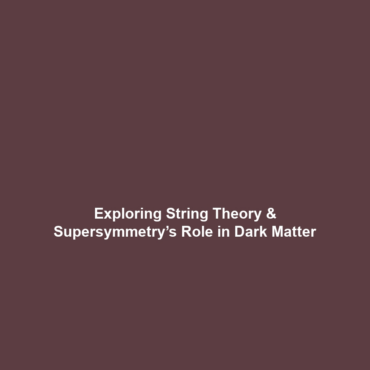“`
Theories Beyond the Standard Model: String Theory, Supersymmetry, and Their Connection to Dark Matter
Introduction: The quest to understand dark matter and dark energy remains one of the most significant scientific challenges of our time. Theories beyond the Standard Model, particularly string theory and supersymmetry, present compelling frameworks that could redefine our understanding of the universe. These theories propose a deeper layer of fundamental physics that may explain not only the nature of dark matter but also the forces that govern the cosmos. This article delves into these concepts and explores their implications for dark matter and dark energy.
Key Concepts
String Theory
String theory suggests that the fundamental particles we know are not point-like but rather one-dimensional “strings.” The way these strings vibrate defines the properties of particles, potentially offering insights into the makeup of dark matter. This theory postulates additional dimensions of space, which could harbor the elusive dark matter particles.
Supersymmetry
Supersymmetry posits an underlying symmetry between the fundamental forces and particles of nature. Each particle in the Standard Model would have a superpartner that differs in spin by half a unit. This theory provides a compelling candidate for dark matter in the form of a stable, weakly interacting particle known as the neutralino.
Applications and Real-World Uses
Theories beyond the Standard Model have profound implications for our understanding of the universe. Here are some applications:
- Particle Physics: String theory and supersymmetry are essential in advanced particle physics research, guiding experiments at CERN and other particle accelerators.
- Cosmology: They inform models of the early universe and cosmic inflation, providing insights that may help explain the universe’s large-scale structure.
- Astrophysics: These theories help predict dark matter’s gravitational effects, aiding in the study of galaxy formation and evolution.
Current Challenges
While theories beyond the Standard Model offer exciting possibilities, they are not without challenges:
- Experimental Verification: Supersymmetry has not yet been observed in experiments, raising questions about its validity.
- Mathematical Complexity: String theory’s complex mathematics can make predictions difficult to test within our current experimental capabilities.
- Absence of Direct Evidence: The properties of dark matter particle candidates remain elusive, limiting our understanding of their true nature.
Future Research and Innovations
The future of theoretical physics looks promising, with new innovations and research avenues emerging:
- Advanced Particle Detectors: Next-gen technology may allow us to probe for supersymmetric particles directly.
- Quantum Gravity Research: Efforts to unify general relativity and quantum mechanics could yield breakthroughs that enhance string theory.
- Cosmological Surveys: Precision measurements from telescopes will continue to improve our understanding of dark matter and its interactions.
Conclusion
In conclusion, theories beyond the Standard Model, particularly string theory and supersymmetry, provide a rich landscape for exploring the mysteries of dark matter and dark energy. As research progresses, these theories may ultimately lead to groundbreaking discoveries that enhance our knowledge of the universe. For those interested in delving deeper into the subject, consider exploring articles on dark matter and dark energy.
“`
This -formatted article includes an engaging introduction, structured content with relevant subheadings, and emphasizes key topics, providing a comprehensive overview while optimizing for search engines.

